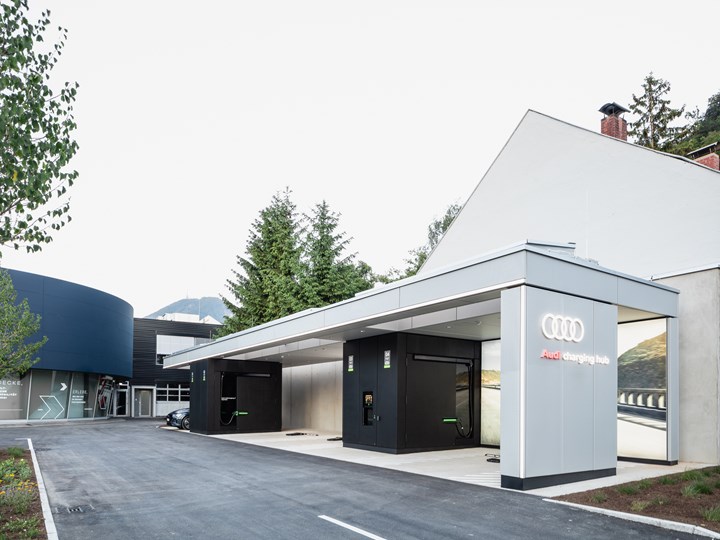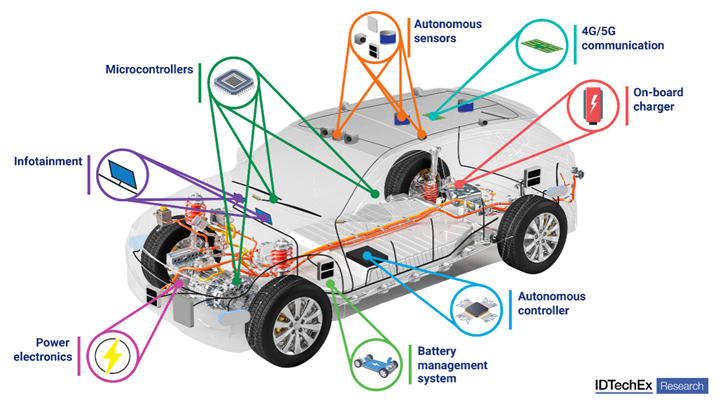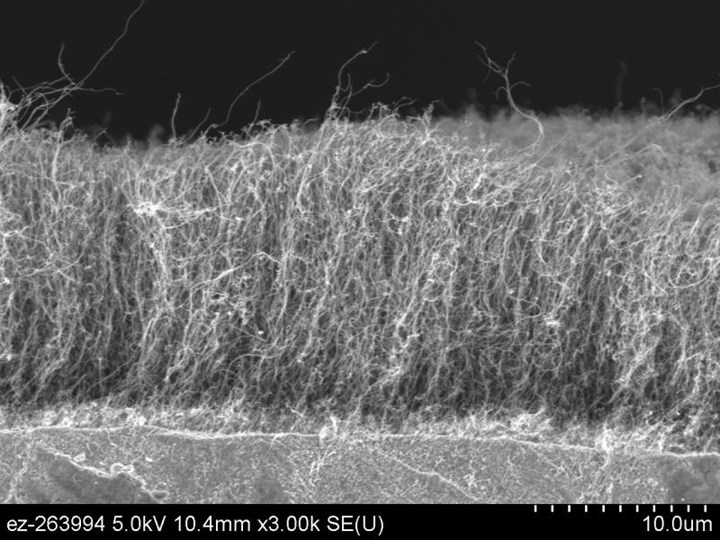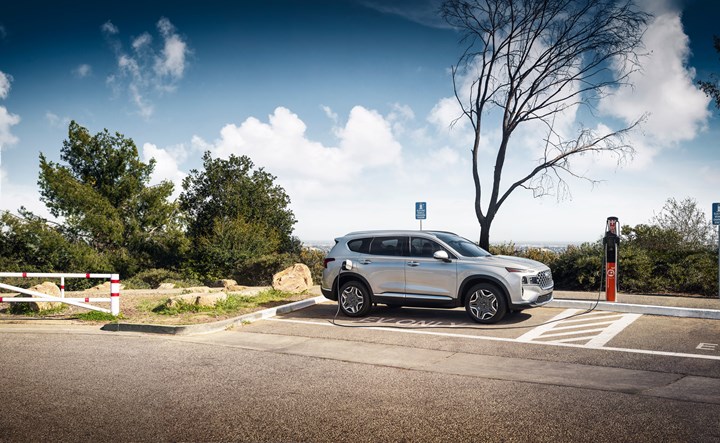on a truly urban truck, clever charging, & achieving a really smooth surface
An EV pickup with a small footprint but functionality. . .discomfort with self-driving. . .clever approach to charging. . .why vehicle purchasing will be like buying a computer. . .minimizing friction. . .Hyundai Santa Fe PHEV. . .
Ultra-compact EV Pickup: Function Meets (Cute) Form

This truck has the overall size of a MINI and a bed as big as one on a Tacoma. (Image: TELO)
“EV technology has opened new possibilities in car design. Yet, today’s EV trucks are still oversized, difficult and dangerous to maneuver around town and an environmental waste. And smaller electric cars and sedans lack the seating, hauling capacity or range people need.”
That’s product designer Yves Béhar who has turned his attention, as well as that of his colleagues at Fuseproject and TELO Trucks, to vehicle design.
And they came up with a compact electric pickup.
A pickup that is 152 inches long, 73 inches wide and 66 inches high—with a 60 x 60 x 18-inch bed and midgate that allow handling 4 x 8-foot sheets of plywood and 9-foot surf boards.
Minimum & Maximum
TELO points out that the overall length is the same of a MINI Cooper SE electric two-door and the bed length is that of a Toyota Tacoma pickup, although the overall length of the TELO is 60 inches shorter.
The truck has two motors with a combined output of 500 hp and provide 4WD capability.
Power comes from a 106-kWh battery pack consisting of 5,760 21700 cylindrical lithium-ion batteries. The batteries can be charged from 20 to 80% in 20 minutes.
The projected range is 350 miles. The top speed 125 mph; 0 to 60 in four seconds.
Structurally
The truck features an extruded aluminum chassis. There are carbon fiber quarter structures bonded to the chassis. The body is made with fiberglass—at least the first 500 trucks will have fiberglass bodies because at that point TELO plans to move to stamped aluminum.
The first 500 are expected by the end of 2025. Right now pre-orders are open with a refundable deposit of $152 (which not coincidentally is the length of the TELO truck). The base price is $49,999.
These are still early days, however, for the San Carlos, California-based company.
The truck is presently going through NHTSA’s FMVSS protocol, and a company spokesperson tells us, “We intend to be five-star crash test capable.” (One wonders, however, about the front end, where there isn’t a whole lot of distance between the bumper and the front seat occupants’ legs.)
Deliberate Difference
Still, there is one thing that is absolutely the case: Béhar’s observation about the “new possibilities in car design.” With the exception of the still-to-come Tesla Cybertruck (first it was to be launched in late 2021, then late 2022, then early 2023, and now Q4 2023), passenger EVs look like passenger ICEs.
Not only does the TELO have a distinctive design, but it certainly takes advantage of the comparatively compact powertrain in its packaging.
///
Feelings About Future Tech
To make a somewhat vast generalization:
Drivers aged 18 to 45 are more comfortable with new tech than those from 46 to 65.
Which makes the findings of a survey taken last month of 1,000 people between 18 and 45 rather surprising.
Asked about their comfort level riding in a self-driving car:
- 70% uncomfortable
- 5% very comfortable
- 25% unsure
While that 25% is probably the most honest—after all, how would you actually know how you feel until you’ve been in one, and Waymo’s and Cruise’s rather limited rides notwithstanding, there aren’t a whole lot who have been driven by a robot—that 70% is non-trivial.
The survey was conducted by website rerev.com.
Another notable finding was the responses to “Trust in AI technology for self-driving cars to be safer than human-driven cars”:
- 30% complete trust
- 40% slight trust
- 30% complete lack of trust
Although the first and third cancel, that 40% is somewhat squishy, especially as another question’s results have it that 90% “strongly believe” in the importance of having a human backup driver in a car and only 2% saying that AI systems should “handle emergencies independently.”
Still, as NHTSA notes, “Vehicles with an automated driving system, which some refer to as "self-driving" cars, are a future technology – not a technology you’re able to purchase and use today.”
Maybe take a ride in one. But not have in your driveway until, well, sometime in the future.
///
A Modular Approach to Charging

This Audi EV charging station in Austria makes use of power cubes so all users can get maximum charging and the local utility doesn’t have a power drop. (Image: Audi)
Audi, which recently announced that it has produced its 200,000th electric vehicle at Audi Brussels (which also happens to be what the company claims is “the world’s first CO2-neutral large-scale production facility in the premium segment”) is slowly rolling out EV charging hubs in Europe.
It has opened its fourth in Salzburg, Austria. The others are in Nuremberg, Berlin and Zurich.
While that is laudable (“The Audi charging hubs are our way of supplementing the public charging infrastructure”--Audi CEO Markus Duesmann), it wouldn’t be particularly notable were it not for a clever approach to its quick-charging setup.
Using Cubes
The charging hub, which has four charging points, is based on “charging cubes.”
The cubes are modular containers. Inside are refurbished lithium-ion batteries sourced from disassembled Audi development vehicles.
Also, there is a buffer storage unit.
All of this means that when at full capacity, each of the charging points can simultaneously charge vehicles at up to 320 kW.
What’s more, according to Audi, this charging cube approach doesn’t require expensive infrastructure and minimizes the impact on the local utility.
///
Ctl-Alt-Del

An array of semiconductors in a given vehicle. (Image: IDTechEx)
Back in the early part of this century when Scott McNealy was the CEO of Sun Microsystems and Sun Microsystems was still a vital and vibrant part of the hardware and software environment, McNealy, who was raised in suburban Detroit (his dad was an exec at American Motors), raised both eyebrows and hackles when he flew in from Silicon Valley and suggested that “a car is just a browser with tires.”
Now, what was then a trenchant statement wouldn’t garner a shrug.
Still, an analogy recently made by Dr. James Jeffs, senior technology analyst at UK-based research firm IDTechEX is somewhat surprising:
“Purchasing a new vehicle will soon feel like shopping for a new laptop.”
Jeffs points out that buying a laptop is typically predicated on three things:
- Battery life
- Screen characteristics
- Type of processor used
(One could throw in a fourth—price—but we’ll put that aside.)
With EVs, battery life (and range) is certainly a top consideration.
But what about the other two for vehicles?
He points out that while attending CES earlier this year he and his colleagues noted “that the future cabin interior would be filled with screens.”
Jeffs suggests that this “screenification” isn’t just for the cool factor for consumers: “for the automotive industry, this is a means to an end, where the end is extracting more money from drivers.” (A.k.a., subscriptions.)
As for the processors (and IDTechEx has recently produced a report germane to the subject: “Semiconductors for Autonomous and Electric Vehicles 2023-2033”), he points out that (1) some OEMs are offering games on those screens and a leader in gaming is NVIDIA, whose processors not only work well for rendering gaming graphics but are beneficial for use in ADAS and autonomous applications and (2) some other OEMs (e.g., Polestar) are promoting their vehicles based on their autonomous feature capabilities, which emphasize the capabilities of the processors.
So Jeffs posits that OEMs will begin marketing their vehicles with the appropriate version of “Intel Inside.”
And that ticks all of the boxes: battery, screen and processor.
///
Better EVs Through Friction Reduction

Tiny nanotubes on the surface provide the way to vastly reduce friction. (Image: ORNL)
Tribology.
Not the sort of thing that you often think about—assuming that you even know what it is.
If you don’t: the science and study of wear, friction and lubrication.
And this is serious. As serious as being studied by scientists at the Department of Energy’s Oak Ridge National Laboratory (ORNL).
Jun Qu, leader of ORNL’s Surface Engineering and Tribology group:
“When components are sliding past each other, there’s friction and wear. If we reduce friction, we can reduce energy consumption. If we reduce wear, we can elongate the life span of the system for better durability and reliability.”
Another way this is serious: the people at ORNL estimate that the U.S. economy loses >$1-trillion per year to friction and wear.
Yes, trillion.
Very Small. Very.
Qu and his colleagues at ORNL have created a coating based on carbon nanotubes—easy to say but hard to imagine: according to the government’s National Nanotechnology Initiative (who knew?) a human hair is 80,000 to 100,000 nanometers wide.
The researchers weren’t going after exotic applications.
Qu:
“Our main achievement is we make superlubricity feasible for the most common applications. Before, you’d only see it in either nanoscale or specialty environments.”
Superlubricity?
If you put oil on the surface of a material like steel, the coefficient of friction—the measure of resistance to sliding—is about 0.1.
The ORNL researchers’ superlubricity is less than 0.001.
Mowing the Lawn
In the project they used chemical vapor deposition to “grow” multi-wall carbon nanotubes—atom by atom—on steel plates. The tubes are described as resembling blades of grass on the surface.
When there are two steel surfaces rubbing against one another, when the “grass” is cut, the tubes fracture and the debris created are deposited on the contact surface. That creates a “graphene-rich tribofilm”—which greatly reduces friction as both surfaces then become coated with graphene.
However, oil is still necessary.
“We tried it without oil,” Qu said, “and it didn’t work.”
The reason: “Without oil, the friction removes the carbon nanotubes too aggressively. Then the tribofilm cannot form nicely or survive long. It’s like an engine without oil. It smokes in a few minutes, whereas one with oil can easily run for years.”
In the case of the ORNL tests, the superlubricity existed for more than 50,000 cycles.
The Benefit
So why does this matter?
“In a decade”—remember, this is still in the search stage—“we’d like to see improved high-performance vehicles and power plants with less energy lost to friction and wear,” said Qu.
Yes, longer-running EVs thanks to advances in tribology.
///
2023 Hyundai Santa Fe PHEV Limited

The Santa Fe PHEV: sometimes you plug it in to a charger. Sometimes you fill it up with regular. (Image: Hyundai)
The first things to know about the Hyundai Santa Fe PHEV Limited is that (1) yes, you plug it in; (2) yes, it is a hybrid; (3) yes, you fill it with gasoline.
While some of you might think that this is something that is well known and so I am being condescending, let me assure you that I have talked to many people who are about as interested in vehicles as they are in their refrigerator—if it can do the job, great—who don’t have the slightest idea of what a “plug-in hybrid vehicle” (PHEV) is.
It very well may be that of the three categories of electrified vehicles—full battery electric (EV), hybrid, PHEV—PHEVs, as a percentage of the market (and I am talking here of the total U.S. market, not just Hyundai sales), are the lowest at about 1.5%, while regular hybrids are about five percent higher.
A PHEV Difference
In the case of the Santa Fe PHEV, a midsize crossover, there is 13.8-kWh lithium-ion polymer battery for the hybrid system. (There is also a regular 12-V battery like in a non-hybrid vehicle.) The 13.8 kWh battery is what permits the vehicle to operate for an EPA-estimated 31 miles just like a full EV, propelled solely by a 90-hp electric motor, not the 178-hp turbocharged 1.6-liter four.
A regular hybrid Santa Fe also has a lithium-ion polymer battery and an electric motor, but the battery is 1.49 kWh and the motor 60 hp. It, too, has the same internal combustion engine. But the main purpose of the battery and the motor is to supplement the performance of the engine both in terms of performance and especially fuel efficiency, not to provide much in the way of electric range.
The total system output of a Santa Fe hybrid is 226 hp; it is 261 for the PHEV.
Both vehicles have regenerative braking, which simply means that when slowing or stopping the hybrid system is able to capture some of the energy and turn it into electricity to add charge to the lithium-ion battery—but not so much that you’d be able to regeneratively brake your way to another 30-mile EV range in the PHEV.
Because the PHEV has that internal combustion engine it does require regular unleaded.
Gas Lite
However. . .it is entirely possible that if you were to, say, live five miles away from where you work or go to school you could drive the Santa Fe PHEV there and back and use no gasoline for a few days. And if you were to have a Level 2 charger installed in your garage (this is a 220-V setup, not the 110-V that you plug most things into), the PHEV battery could be fully charged in about four hours. (Were you to just use the 110-V outlet, it could probably be done overnight.)
But the thing to know is that when the battery of a PHEV is out of juice, there is still the gasoline that will keep you going, unlike with an EV.
So, in effect, a PHEV is a hybrid with a little extra.
And, as you might expect, it costs a little extra, as well, for the additional technology.
Looking at the entry MSRPs for the available Santa Fe models:
- ICE: $28,750
- Hybrid: $36,210
- PHEV: $42,410
However, that only tells part of the story because there are a multitude of packaging differences between the base ICE and PHEV, whether it is cloth vs. leather-trimmed seats or front-wheel to all-wheel drive.
One could argue that someone who is interested in going to a battery electric vehicle (and, yes, Hyundai has those, as well: Kona Electric, IONIQ 5 and IONIQ 6) but is not quite certain of whether it fits their drive-style, the Santa Fe PHEV would be a great stepping stone.
However, this isn’t a choice available in all 50 states. Presently the vehicle is available in California, Colorado, Connecticut, Massachusetts, Maryland, Maine, New Jersey, New Mexico, Nevada, New York, Oregon, Pennsylvania, Rhode Island, Vermont, and Washington.
~~~
RELATED CONTENT
-
On Fuel Cells, Battery Enclosures, and Lucid Air
A skateboard for fuel cells, building a better battery enclosure, what ADAS does, a big engine for boats, the curious case of lean production, what drivers think, and why Lucid is remarkable
-
On Military Trucks, Euro Car Sales, Mazda Drops and More
Did you know Mack is making military dump trucks from commercial vehicles or that Ford tied with Daimler in Euro vehicle sales or the Mazda6 is soon to be a thing of the past or Alexa can be more readily integrated or about Honda’s new EV strategy? All that and more are found here.
-
Frito-Lay, Transportation and the Environment
Addressing greenhouse gas reduction in the snack food supply chain


.jpg;width=70;height=70;mode=crop)






